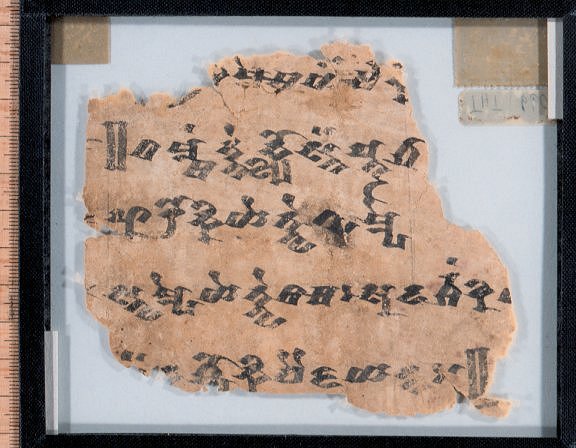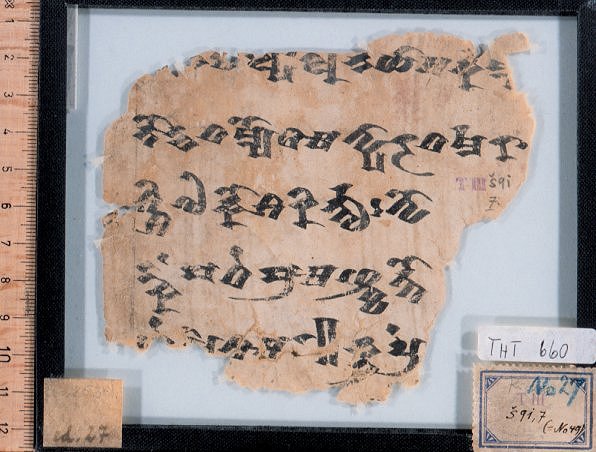A 27
| Known as: | A 27; THT 660 |
|---|---|
| Cite this page as: | Gerd Carling; Georges-Jean Pinault; Melanie Malzahn; Michaël Peyrot. "A 27". In A Comprehensive Edition of Tocharian Manuscripts (CEToM). Created and maintained by Melanie Malzahn, Martin Braun, Hannes A. Fellner, and Bernhard Koller. https://cetom.univie.ac.at/?m-a27 (accessed 01 Jul. 2025). |
Edition | |
| Editor: | Gerd Carling; Georges-Jean Pinault; Melanie Malzahn; Michaël Peyrot |
| Date of online publication: | 2012-10-31 |
Provenience | |
| Main find spot: | Shorchuk |
| Specific find spot: | Stadthöhle |
| Expedition code: | T III Š 91.07 |
| Collection: | Berlin Turfan Collection |
Language and Script | |
| Language: | TA |
| Script: | classical |
Text contents | |
| Title of the work: | Unknown Avadāna |
| Passage: | Dharmarājika deeds |
| Text genre: | Literary |
| Text subgenre: | Jātaka/Avadāna |
| Verse/Prose: | prose; verse |
Object | |
| Manuscript: | A 1-54 |
| Material: | ink on paper |
| Form: | Poṭhī |
| Number of lines: | 6 |
Images
Images from titus.fkidg1.uni-frankfurt.de by courtesy of the Thesaurus Indogermanischer Text- und Sprachmaterialien (TITUS).
Transliteration
| lf | 2 |
|---|---|
| a2 | (– –) ·[ñ]·[¯] [¯s] me¯ ¯m yä¯ ¯rm k· /// |
| a3 | || ta mmaṃ tne klyo snä ṣtra gā ○ /// |
| a4 | hu rro ki ye twe wa mpe ○ /// |
| a5 | swa mpe ye twe sa¯ ¯m : su da rśaṃ ri [y]· /// |
| a6 | ·ä [k](·)(·) śyo ki vai ja ya¯ ¯nt : 1 || /// |
| b1 | – n(·) [ka] lpā lu ne yā ma [r]ka mpa /// |
| b2 | to¯ ¯nt ta myo sa¯ ¯m wyā¯ ¯r dha rma rā /// |
| b3 | śśi o ko śa ri rntu : wo ○ /// |
| b4 | ṅkaṃ ba dhe bra¯ ¯m ñka tto ○ /// |
| b5 | [ñ]e mi sa¯ ¯m 1 || ku pre /// |
Transcription
| lf | 2 |
| a2 | n1 – – ·ñ(i)s mem yärm k· /// |
|---|---|
| a3 | n2 ॥ täm mäṃt ne klyosnäṣträ gā /// (ma)¬ |
| a4 | hurr oki yetwe wampe /// (ārkiśoṣi)¬ |
| a5 | s wampe yetwe säm : sudarśaṃ riy(aṃ) /// |
| a6 | (ñ)äk(ta)śy oki vaijayant : 1 ॥ /// |
| b1 | – n· kälpāluneyā märkampa(l) /// |
| b2 | n3 tont tämyo säm wyār dharmarā(jik) /// |
| b3 | n4 śśi oko śarirntu : wo /// |
| b4 | n5 ṅkaṃ badhe bram-ñkätt o(ki) /// |
| b5 | ñemi säm 1 ॥ kupre(ne) /// |
Translation
| a2 | ... the measure [and] limit of ... |
|---|---|
| a3 | || Just as ... is heard ... |
| a3+ | ... (dia)dem as it were, ornament, decoration ... |
| a4+ | ... this one [is] the decoration [and] ornament of the (world). |
| a5 | (In) the city Sudarśana ... |
| a6 | ... like the Vaijayanta [palace] of the ... g(ods). |
| b1 | ... through obtaining of ..., the Law ... |
| b2 | ... the (foundations of the relics) have been put (in the stūpa). Therefore this monastery (is called) Dharmarājika ... |
| b3 | ... (they obtained) bodies as the fruit of (deeds/merits). ... |
| b4 | ... in (the palace) Badhe l(ike) god Brahman ... |
| b5 | ... this jewel 1 || If ... |
Other
| a3 | Wie man hört [bzw. man hört nämlich [folgendes] ], ... Gā- ... (Schmidt 1974: 220) |
|---|
Commentary
Remarks
| Transcription and references have been transferred from the "Text and Reference Database of the Tocharian A Language" (Gerd Carling Lund University) (funded by the Bank of Sweden Tercentenary Foundation and SCAS). | |
| Transcription and translation are based on Carling et al. 2009. | |
| Small fragment of the left side. The string hole space is preserved in lines 3 and 4. Lines a1 and b6 are lost. There are traces of signs in the margin of the recto side. |
Philological commentary
| n1 | ·ñ(i)s is most likely a gen.sg. (or pl.?). |
|---|---|
| n2 | The phrase mäṃt ne klyoṣtä(r) also attested in the small fragment m-tht2166 a 2. |
| n3 | Probably, tont is the fem.nom.pl. PPt of 'to put'. For the name dharmarājika- lit. 'belonging to a king of the Law', see Edgerton 1953: 281a and Bechert and Waldschmidt 1973 II: 530a; actually, it refers to a monument serving for the relics of the Buddha. |
| n4 | One may restore either (pñintwā)śśi oko or (lyalypäntwā)śśi oko. |
| n5 | The most likely restoration is (ṣtā)ṅkaṃ 'in the palace'. The personal name Badhe does not make sense, because there is no Sanskrit form badha-; it may stand for *Vadhe from Skt. vadha-, which would be a name by itself or a shorten form of a compound name; cf. Edgerton 1953: 397a. In theory, one may think of Skt. bādha- 'oppresser' Monier-Williams 1899: 728a, but this noun does not make a proper name. |
References
Online access
Edition
Sieg and Siegling 1921: 20; Sieg and Siegling 1921 p. 20
Translations
Schmidt 1974: a3 (220)
Bibliography
Bechert, Heinz, and Ernst Waldschmidt. 1973. Sanskrit-Wörterbuch der buddhistischen Texte aus den Turfan-Funden. Göttingen: Vandenhoeck & Ruprecht.
Carling, Gerd, Georges-Jean Pinault, and Werner Winter. 2009. A dictionary and thesaurus of Tocharian A. Volume 1: Letters a-j. Wiesbaden: Harrassowitz.
Edgerton, Franklin. 1953. Buddhist Hybrid Sanskrit grammar and dictionary. New Haven: Yale University Press.
“The International Dunhuang Project: The Silk Road Online.” n.d. http://idp.bl.uk.
Monier-Williams, Monier. 1899. A Sanskrit-English dictionary. Etymologically and philologically arranged with special reference to cognate Indo-European languages. new edition, greatly enlarged and improved, London: Clarendon Press (several reprints).
Schmidt, Klaus T. 1974. “Die Gebrauchsweisen des Mediums im Tocharischen.” PhD, Universität Göttingen.
Sieg, Emil, and Wilhelm Siegling. 1921. Tocharische Sprachreste, I. Band. Die Texte. A. Transcription. Berlin/Leipzig: de Gruyter.
Sieg, Emil, and Wilhelm Siegling. 1921. Tocharische Sprachreste, I. Band. Die Texte. A. Transcription. Personal annotated copy of Wilhelm Siegling. Scanned by Douglas Q. Adams with the technical assistance of Michael Tarabulski and Kevin Dobbins. Berlin/Leipzig: de Gruyter.
Gippert, Jost, Katharina Kupfer, Christiane Schaefer, and Tatsushi Tamai. n.d. “Thesaurus Indogermanischer Text- und Sprachmaterialien (TITUS): Tocharian Manuscripts from the Berlin Turfan Collection.” http://titus.fkidg1.uni-frankfurt.de/texte/tocharic/thtframe.htm.




